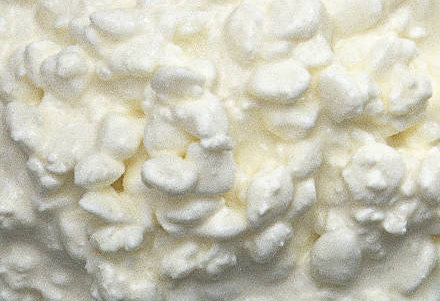You may have noticed many types of cottage cheese in your grocery dairy section and wondered what the difference was between them all. Outside of the several brands that are available, there are different types of milkfat percentages and curd sizes. We will explain what this all means below.
Cottage Cheese Milkfat
There are four types of commonly available milkfat percentage cottage cheese products. These are nonfat, 1 percent, 2 percent, and regular (4%).
- Nonfat – This is also known as fat free or 0 percent cottage cheese. While it is labeled as not having fat, it can actual have up to 0.5% total fat and still be considered nonfat. According to the USDA, a nonfat labeled product cannot have added fat “unless ingredient declaration lists a fat-containing ingredient followed by an asterisk and the statement “Adds a trivial amount of fat.” There are approximately 80 calories in a 1/2 cup.
- 1 Percent – This type of cottage cheese is often referred to as low-fat on the container. It is made from 1 percent milkfat and has about 90 calories per 1/2 cup. The fat content is approximately 1-1.5 grams.
- 2 percent – It is typically also labeled as reduced-fat cottage cheese and is made from 2 percent milkfat. The calories are approximately 90 per 1/2 cup and the fat is about 2.5 grams.
- Regular (4 percent) – Regular cottage cheese is sometimes referenced as creamed cottage cheese because of the cream that is added at the end of processing. It is made from a minimum of 4 percent milkfat. The calories for a 1/2 cup are about 110. The fat is usually 5 grams.
Small Curd and Large Curd Cottage Cheese Differences
The curds are the chunky parts of cottage cheese that are made from curdling milk. There is a product called rennet that is added to milk to aid and speed up the curdling process. However, rennet is not always used or required to curled milk in order to create cottage cheese. The difference between small and large curd cottage cheese is that large curd is made from rennet, while small curd is not. Because the rennet speeds up the curdling process, a lower acidic and larger curd is formed. Many people believe that large curd tastes sweeter due to its lower acidic levels.
Choosing A Cottage Cheese
There are several types of cottage cheese as mentioned above, along with many brands available in grocery stores. You also may factor in ingredients as some are all-natural and others contain preservatives/stabilizers. Another consideration is organic vs. non-organic. Finally, you have to actually like the taste. What it all boils down to is personal preference and what works for your nutritional needs and/or taste buds.


Also theres named styles with different textures
California is a drier denser curd thats somewhat chewy
Country Style Softer and wetter creamier and usually Sweeter than other small curd styles yet still having a hint of tartness that tells you its still “cottage cheese” IMO its the Best of them all…
My mother used to make a cheesecake out of a very small curd cottage cheese. Almost smooth? I remember her having difficult finding it after a time. Any idea what it might have been?
Sounds like “Whipped” cottage cheese to me